I enjoy horror gaming. This can take many forms, with the first RPG I ever got into being Vampire: the Masquerade. The World of Darkness series is steeped in horror, but it’s far from the only horror-based game. Call of Cthulhu is a massively popular horror game with a proven longevity. Ten Candles is a game I previously played and absolutely loved. I’ve also built horror elements into playthroughs of Paranoia and The Dresden Files.
I enjoy horror-based play.
That’s probably why I jumped at the offer of a copy of Dark Space, a collection of sci-fi horror adventures intended for use with a number of different systems. For those unsure of what system to use, it also contains rules for Cthulhu Dark so you can get going right away.
Before I jump into the review, let’s just nab the credits page of the PDF so that we can properly see who put this together:
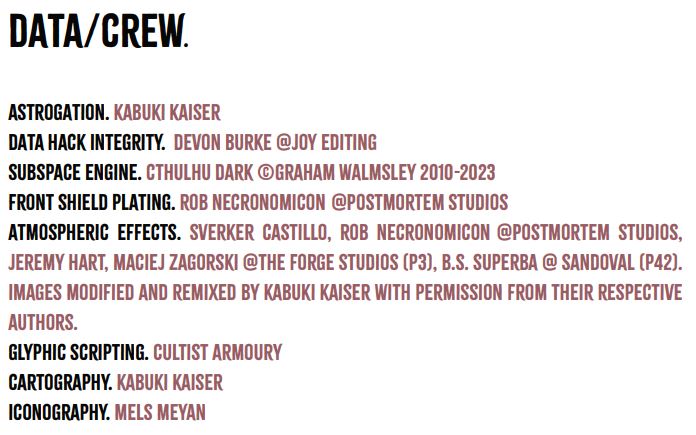
A PDF review copy of this book was provided by the author, for which I promised only to take a look. No further payment was provided or promised and the views represented below are entirely my own. Any link to purchase this book will be an affiliate link through which I will earn a small commission.
Right, let’s go!
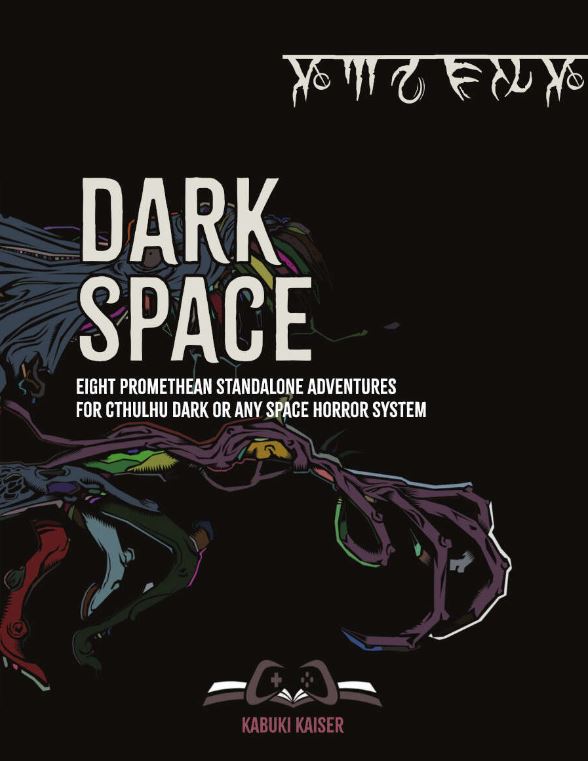
This collection of 8 adventures draws heavily on the established Cthulhu Mythos, as depicted in the works of H. P. Lovecraft. However, whilst the Cthulhu Mythos is set mostly in the 1920s to 1930s, this book takes it into the future and into space, incorporating the well-trodden cosmic horror of Lovecraft with the cosmic exploration of a sci-fi setting. Specifically, this is early exploration. I feel this is an important distinction to make and would like to start this review with a bit of musing on this choice of setting. I’ve gathered up a bunch of half-formed thoughts on the potential of this type of setting:
- Space is often considered the “final frontier”, and the unknown nature of outer space mirrors the cosmic horror themes of the Cthulhu Mythos. Just as Lovecraft’s stories often dealt with the fear of the unknown and incomprehensible, the vastness of space and unexplored planets can evoke a similar sense of awe and dread.
- Space settings, whether on a distant planet or a spaceship, can also create a sense of isolation and claustrophobia. These feelings align with the themes of cosmic horror, as characters are trapped in confined spaces, surrounded by the vast emptiness of space, with unknown and potentially malevolent forces lurking, unseen.
- The Cthulhu Mythos often involves ancient and powerful entities that have existed long before humanity. Placing these entities in a future setting allows for exploring the idea that these cosmic beings have been influencing the universe for eons, and their influence is now reaching humanity in a new and unsettling way.
- The juxtaposition of advanced spacefaring technology with ancient cosmic horrors can create a theme of technological hubris. Humanity’s arrogance in thinking it can conquer the cosmos might lead to unintended consequences, awakening dormant entities that defy understanding and challenge the limits of scientific knowledge.
- The Cthulhu Mythos often involves interdimensional elements. A near-future setting with advanced space travel technology could open up possibilities for interdimensional exploration, bringing entities from other realms into contact with humanity. This can lead to mind-bending and sanity-shattering encounters.
- Lovecraft’s stories often explore the insignificance of humanity in the face of vast cosmic forces. A space setting allows for environmental parallels, where the hostile and indifferent nature of space mirrors the cosmic indifference of Lovecraftian entities.
- The idea of humans colonising distant planets or encountering alien civilisations fits well with Lovecraftian themes. The exploration and colonisation of new frontiers bring with them the potential for discovering ancient secrets and awakening dormant horrors.
- The scientific mysteries inherent in space exploration, such as black holes, dark matter, and quantum phenomena, can be seamlessly woven into the narrative of cosmic horror. These mysteries align with the eldritch nature of the Cthulhu Mythos, blurring the lines between science and the supernatural.
Okay, that was a bit of mental meandering, but I like the idea of this type of setting. By, combining the themes of cosmic horror with the futuristic and unknown aspects of early space exploration one can create a setting that really plays on the fear of the unknown, the fragility of humanity, and the consequences of meddling with forces beyond comprehension.
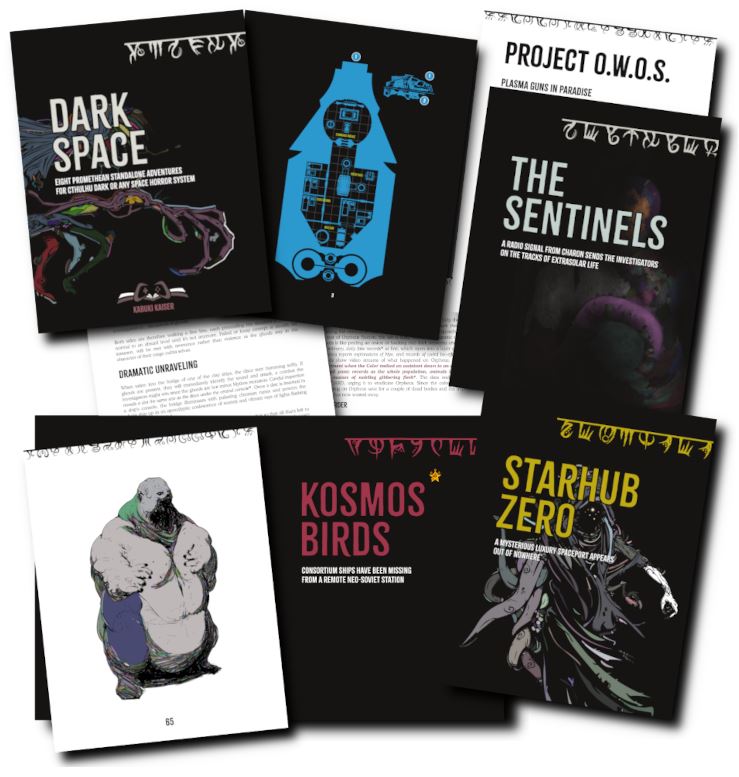
So, that aside, let’s look at the actual content of the book, eh? The book begins with a ‘Play Kit’ section that sets out the intent of the book.
The Play Kit
The most useful thing here is in establishing the setting and trying to set a tone. This is really important. I often feel that the main reason to pick up official adventures for any new game is really to get a solid idea of what type of adventure and what tone the designers intended for the game. Often you get big hints from the early published adventures. Here, it’s laid out plainly.
We get another key piece of information about the setting in the form of the ship. The ship is the Wulian-9, a trading vessel that will be our home over the course of these adventures. The book also has a small picture of the ship, and then some decks plans of the two decks of the Wulian-9.
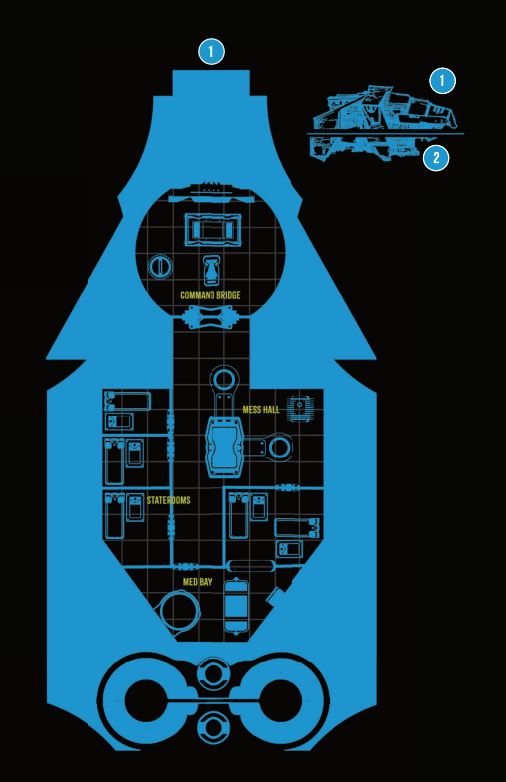
Something I like about this section is the inventory. There’s a simple list of what you will find in each room. This seems a bit mundane at first glance, but is actually quite interesting and useful. You are on a ship, out in the void. If an object is not already on your person or on this list, you don’t have it. There are no stores, nor Star Trek-esque replicators. You’re out there, alone. These are your resources, and these are all of your resources. An inventory seems so obvious in retrospect, but I’ve not seen many books lay it out so plainly and prescriptively.
This section also outlines the crew of the ship, or at least a crew for the ship. it acknowledges that you can create your own characters to use in the game, but provides you with some profiles of crew members that you can use, or which a GM can use as NPCs. I like that you get a good sense of why each character is on a ship, a little bit of their personality, and their motivations. What I really like though is the emphasis on the languages each character speaks. This is an interesting and useful detail. It allows for the possibility of clandestine communication between specific characters speaking in, to take an example from the text, Hindi, to avoid being overheard by the character who speaks English and Italian. Here are some examples of character profiles:

We are told that these adventures are all intended as one-shots, usually completed in short 4-hour sessions. It also suggests that whilst these adventures are intended as standalone stories, there’s some opportunity for campaign play. I appreciate the flexibility on this. I imagine that I’d most likely use this book for one-shot adventures, but if a group responded well to them, I like that there’s an option for some form of continuation, even if it’s intentionally somewhat tenuous or implied.
The Adventures
The mean of the book is the assortment of 8 adventures. Well, I say adventures, but they say investigations. Here’s the full list:
- Orpheus Station
- The Sentinels
- Starhub Zero
- The Clay Ships
- Cold Storage
- Kosmos Birds
- Zargon is Alive!
- Project O.W.O.S
Reading the investigations is very easy because several good decisions made in regard to structure and layout. First of all, the pages are very clean. They were legible, well-spaced, and make good use of subheadings. There’s also some good visual coding here to help GMs know how to use the content. For example, a simple visual element is used to indicate those sections of text that should be read aloud, whilst bold and italic text, as well as colour and asterisks, indicate further guidance regarding rolls, checks, and the like. This coding is defined in the Play Kit section of the book and should be read and understood by the GM to ensure the easy and effective use of the rest of the book.
The advantage of this style of presentation is that the investigations read like prose. Rules elements are folded in and indicated visually, rather than acting in way that would disrupt the natural reading of the text. It helps with immersion and makes the text more consistently engaging, just so long as you put in that small initial effort of learning the visual coding.
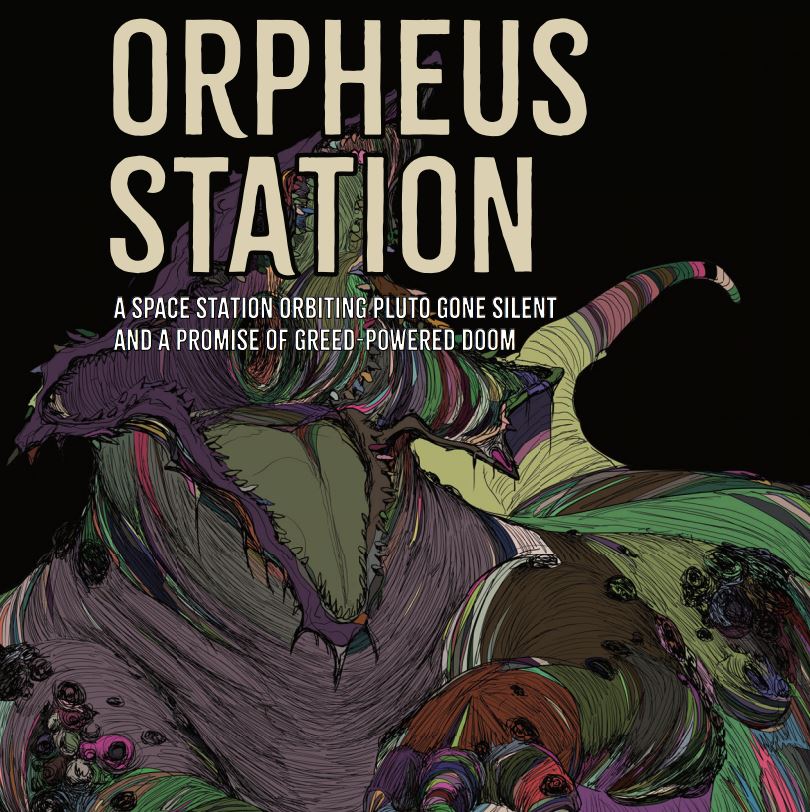
Reading through the first investigation, Orpheus Station, gives us a taste of what’s to come. it begins with a section to be read aloud, setting the scene and setting the players up with questions. This is followed with a section that lays out what exactly happened on the station, written for the benefit of the GM.
At this point, we also get introduced to a classic element of the Mythos, complete with a reference to the Lovecraft novel from which it originated. I’m having to skirt around this to some extent, as I’m very keen not to give spoilers to what is a fantastic, little adventure; and one which I may well run, myself. I like that this section exists to link us back directly and, with the reference to the specific book, demonstrably to the source texts, and that the author then explains the context in which it exists within this setting.
The adventure then proceeds, laying out events, and building on the setting of the titular space station, Orpheus. Five distinct zones are named and defined, with a further, more significant area, being described on the next page.
This Investigation is clear in its structure, includes a good mix of description, guidance, and sections to be read aloud, and ends with some extra investigators (in addition to those previously given in the Play Kit section) for use in this story. This is a really solid adventure that would be fantastic for running at an event.
What of the rest of the adventures? Well, take as read the good design and layout elements that I’ve already mentioned. Beyond that, and given my reluctance to give away spoilers, I don’t intend to go through and give each one a summary or blow by blow. Instead, I will lay out some highlights:
- The quality of writing is good throughout, with fantastic sections of description to read aloud. I really liked the description of the sanctum in The Sentinels (page 21).
- I like the inclusion of spells. Magic as a reality-defying power is an important part of the mythos, and I like that the spells are presented as such here. The assumption on some spells that the group would be ‘foolish’ to cast them is also appreciated!
- Whilst railroading is not generally something that’s liked in RPGs, you do need to engage with the story to get anywhere. As such, any player character who (understandably) doesn’t want to walk into what seems like an obvious trap at the start of Starhub Zero may find themselves compelled by a handy set of hooks that the author provides to push players in the right direction.
- Starhub Zero makes good use of the aforementioned coding when signalling sanity checks to go alongside a description of a horrific, threatening creature, terrifying visions of an otherworldly court, and the sight of being sacrificing themselves willingly (and brutally) to the aforementioned creature.
- Starhub Zero also makes the point, quite correctly, that the final enemy they must face is one against whom, as a Mythos creature, the party can only score at best a pyrrhic victory. I think this tone of near-hopelessness is utterly appropriate to the setting and intent of these investigations.
- Cargo cults are something that I find quite fascinating, and it’s great to see an evolution of the idea in the investigation, The Clay Ships. Given that space travel is still relatively new and slow, and the perils faced by these new colonists, it makes sense that such groups would emerge.
- Cold Storage links firmly and directly back to Lovecraft’s The Shadow Out of Time, by bringing in the Yithians and making reference to their prehistoric wars with the Elder Things.
- Cold Storage gives a good sense of time for the first time in this book. You get a sense of how long travel between different locations actually takes. This is really useful information that might actually have been worth including in the Play Kit.
- I like the shift in focus in Kosmos Birds to a neo-soviet setting. It changes things up and gives some different roleplaying opportunities.
- Zargon is Alive! employs the idea of the hollow world, a classic pulp fiction concept popularised by works such as Edgar Rice Burroughs’ 1914 novel, At the Earth’s Core.
- Zargon is Alive! is also the only adventure that I feel is left really ambiguous at the end, with a single roll of the dice determining survival and no explicit description of what happens after said roll. That said, you can gather a lot of what will happen to the crew should they fail their roll by reading the preceding description of the horror and chaos unfolding before them.
- Nyarlathotep is one of my favourite of Lovecraft’s creations, and I’m delighted that the final investigation of this book, Project O.W.O.S., features his inclusion.
- As such, Project O.W.O.S. heavily embraces the dreaming aspect of Lovecraft’s fiction, sending player characters into nightmares and hallucinations that represent some really fantastic opportunities to engage in some dynamic roleplay.
I think, on balance, my favourite investigation has to be The Clay Ships. I love the whole idea of a sci-fi cargo cult. I love the story to this adventure, too. Project O.W.O.S. does come a close second though, largely for the dreaming aspect and the inclusion of Nyarlathotep.
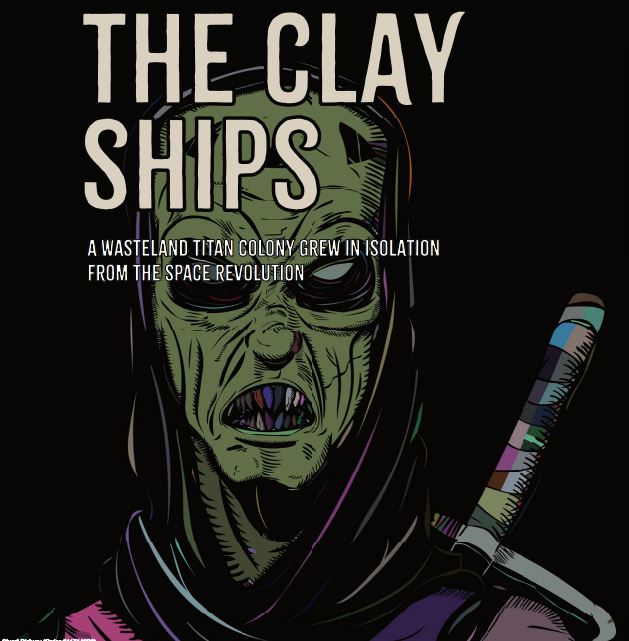
Conclusion
The book also includes some rules for Cthulhu Dark to ensure usability without the necessity of any further books or resources. That’s a nice touch, though I’m not all that familiar with Cthulhu Dark.
The final page of the book also includes two lists. The first details the books by Lovecraft and others that have been references throughout this work. The second is a list of Mythos creatures found throughout these investigations, including an original one created by the author.
When I was asked to take a look at this book I was expecting it to be a labour of love. I got the impression from the outset that the author was a fan of these writings and would endeavour to do them justice in a sci-fi setting. This expectation was met.
What I did not expect, was the elegance of this book. The design is clean and easily accessible. Art is mostly used for the cover pages of each Investigation, and is appropriate and consistent in style. Consistency is art is something I really like in this sort of book. The visual coding laid out in the play kit and used throughout the investigations is something that I wasn’t sure about when I first read it, but was soon convinced of as I read through the investigations. It helps to preserve a readable prose style that isn’t broken up by blatant (dare I say vulgar?) discussion of rules and dice. As someone who likes rules-light games, this is really welcome. It would, after all, be a genuine shame to detract from the high quality of writing evident throughout this book.
I’d definitely recommend Dark Space. When I come to write my resolutions for 2024, I’m intending to put in an aim to run more one-shot adventures. I’d love for some of the investigations from this book for form part of that commitment.
I’m also keen to now dip into the author’s back catalogue and see what other treasure await.
You can click here to view and purchase Dark Space on DriveThruRPG.

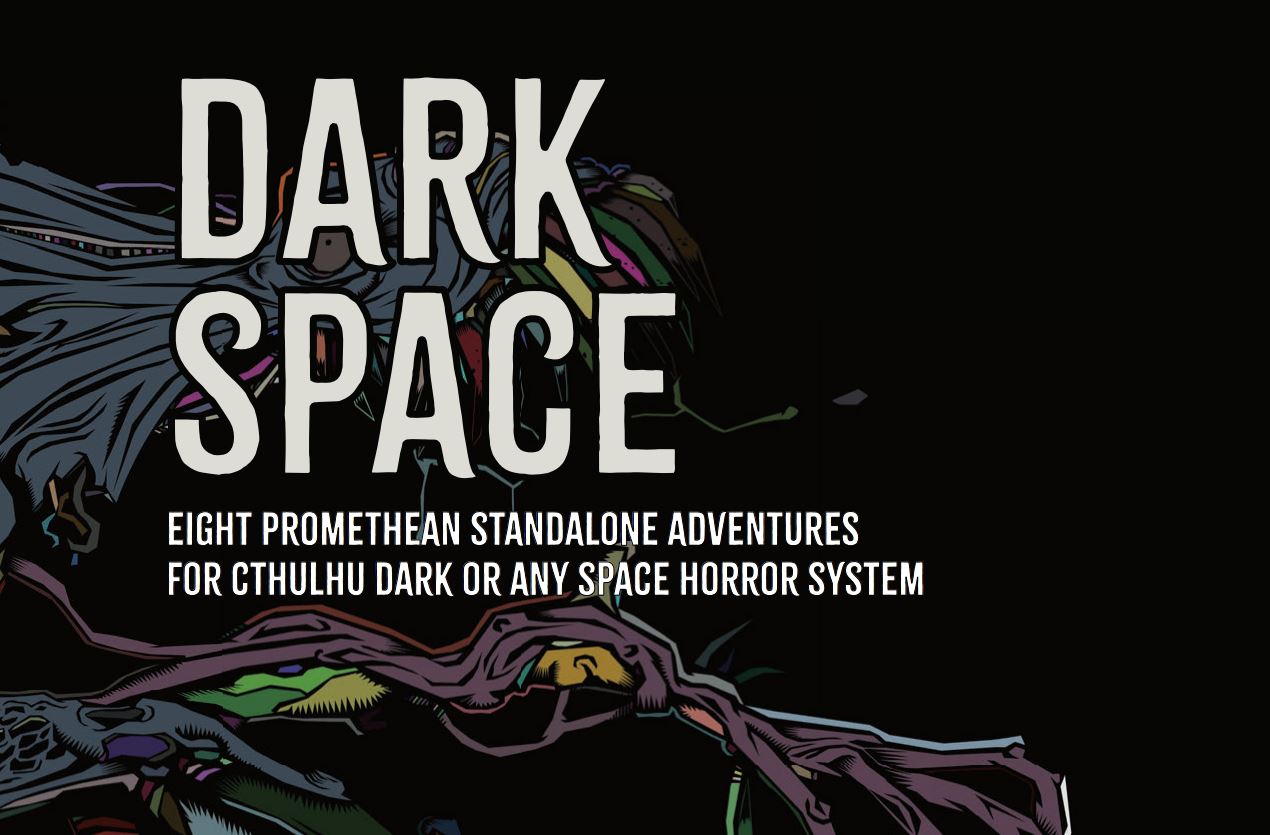
I’m not typically a horror fan, but I do greatly enjoy Call of Cthulhu. My gaming group has been more focused on one-shot’s than campaign play for the last year and this sounds like it both fits what I want in adventures and something my group will have a good time with. Black Friday pricing was the final selling point. I’m looking forward to getting my print copy, and I have the PDF to read while I wait!
LikeLiked by 1 person
I’m swithering over ordering a print copy, too.
LikeLike
Great review. I love Space Horror, having recently played through Dead Space remake, i love that franchise, and, ofcoarse, Alien
LikeLiked by 1 person